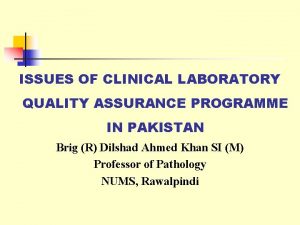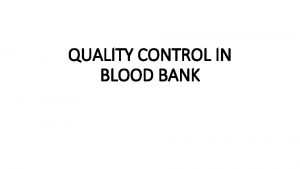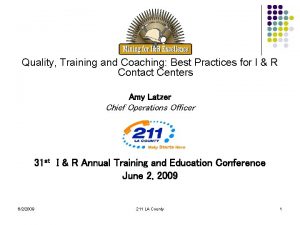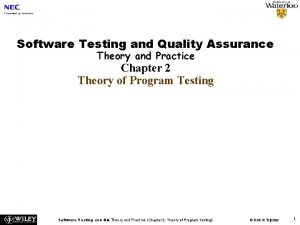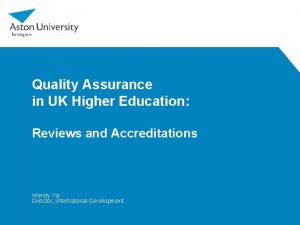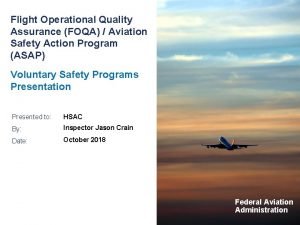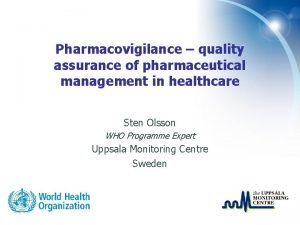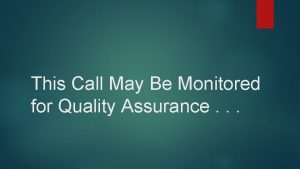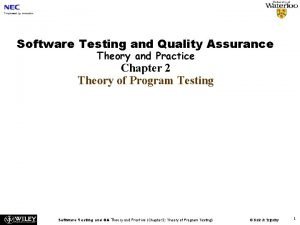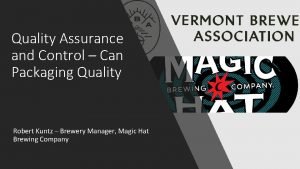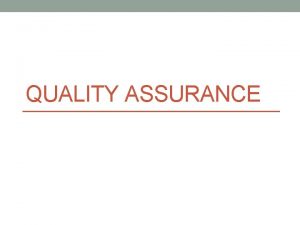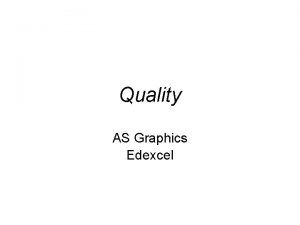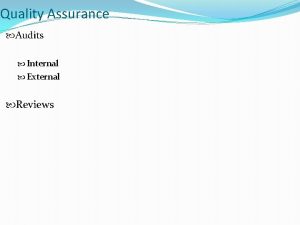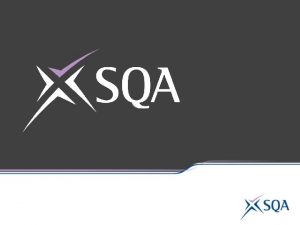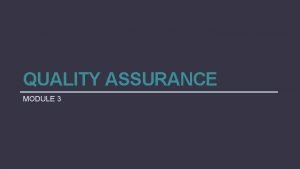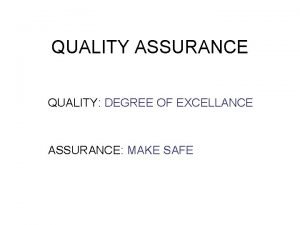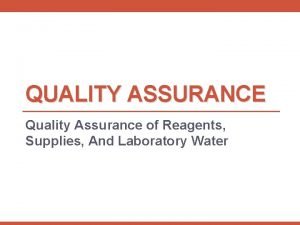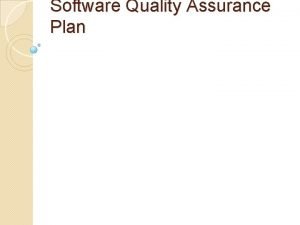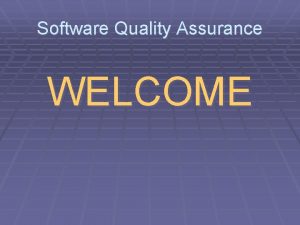NVAOs external quality assurance procedures Axel Aerden 17

















- Slides: 17

NVAO’s external quality assurance procedures Axel Aerden 17 April 2012

The position of NVAO ‘Higher education’ Re c Fu ogn nd itio ing n V Pr alue oo f o for € fu se Enhancement t or ion p p t Su ecia pr Ap ty ali s u Q ces Ac NVAO Accountability Information ‘Government’ ‘Society’ Support (Consumer) protection 2

NVAO’s Scope of work • Recognition of new higher education institutions • Institutional audits • Initial accreditation • (New) programmes that want to offer a recognised degree • All bachelor and master’s programmes, including associate degrees and research masters (MPhil) • Accreditation • programmes that already offer a recognised degree • Publication of decisions (and officially recognised degrees) • Internationalisation 3

NVAO’s overall approach Audit Institution Programme Official register • Focus on policy & practice re. internal QA system teaching and learning Report (Initial) accreditation • Concentrate on content (& focus on performance) learning outcomes Report Publication 4

Aim of NVAO’s system (1/2) • Balancing accountability and enhancement • Stimulate quality culture institutional audit • Start from institutional vision/policy on (internal) QA • Focus on functioning of (internal) QA system with respect to teaching & learning • Commit professionals / Increase academic ownership programme assessment • Focus on content; not on procedures • Assess learning outcomes; not quantitative elements 5

Aim of NVAO’s system (2/2) • Balancing accountability and enhancement • Reward earned trust limited programme assessment • Two types of programmes assessments • Stimulate HE to aim above threshold accredit as satisfactory, good, excellent 6

5. Does the institution have an effective organisation and decision-making structure regarding the quality of its programmes? Institutional audit • Standard 5: Organisation and decision-making structure 4. How can the institution demonstrate that it systematically improves the quality of its programmes? • Standard 4: Improvement policy • Standard 1 and 2 : Vision and policy act 3. How does the institution measure the degree to which this vision is realised? • Standard 3: Results check plan 1. What is the vision of the institution regarding the quality of the education it provides & of the development of a quality culture? 2. Does the institution have an appropriate policy to realise this vision? do • Effective implementation (by progr. assessment ) Positive / Negative / Conditional 7

Institution Yes Institutional audit Programme assessment Is this institution recognised? No Recognition procedure Has this institution undergone an institutional audit? Yes + decision No - decision Limited programme assessment Extensive programme assessment 8

Programme assessment Improvement period Programme assessment Limited programme assessment Extensive programme assessment Is this programme on the register/ recognised? (Lim. /Compr. ) accreditation procedure - decision + decision (Lim. /Compr. ) initial accreditation procedure + decision - decision Satisfactory - Good - Excellent Deleted from register Included on register 9

Programme assessment Limited programme assessment Extensive programme assessment Assessment of • content of the programme • focus on performance Detailed assessment of • content, • policy and • procedures 3 standards 16 standards Themes 1. Intended learning outcomes 2. Programme and staff quality 1. Intended learning outcomes 2. Programme 3. Staff 4. Services 5. Quality assurance system 3. Achieved learning outcomes & 6. Achieved learning outcomes & Learning assessment Conclusion: unsatisfactory, good, excellent quality 10

Focus on learning outcomes Programme Module x Module y Module z . . . Intended LOs Achieved? . . . … (C. &) LOs Assessment (ECTS) Course catalogue . . . 11

Importance of learning outcomes (& ECTS) • Direct window on what programmes aims to do & what a programme actually does • Less focus on policy, process & procedures • But process & procedures are easier to assess • Facilitates international transparency & comparability • E. g. International benchmarking • Open to all types of teaching & learning • Technology Enhanced Learning / Distance learning • Work-based learning / Assessment of prior learning • Provides a common language for HE & stakeholders • Teaching & Learning 12

AIMS FOR: mutual recognition of accreditation & quality assurance decisions RESULTS OF THIS COOPERATION: • Code of good practice (2004) • Principles for the selection of experts (2005) • Principles for accreditation procedures regarding joint programmes (2007) • Bilateral mutual recognition of accreditation agreements (2007) • Qrossroads. eu (2008) • Principles regarding learning outcomes in accreditation procedures (2009) • Multilateral agreement regarding joint programmes (2010) PARTICIPANTS: ECA Partners (& one observer) Multilateral agreement re. joint programmes Mutual recognition agreements 2007 Mutual recognition agreements 2010 -2011 www. ecaconsortium. net 13

THANK YOU FOR YOUR ATTENTION a. aerden@nvao. net - @AAerden www. nvao. net - www. qrossroads. eu 14

Programme assessment scale • • • Generic quality The quality that in all reasonableness could be expected of a bachelor’s or master’s programme within higher education, and this from an international perspective. Unsatisfactory The programme does not provide generic quality. Satisfactory The programme provides generic quality. Good The programme is of notably higher quality than generic quality. Excellent The programme is of a quality very much above generic quality and fulfils an exemplary role for other relevant programmes. 15

Expert panel composition (1/2) • At least four members, one of whom is a student; • at least two authoritative subject-matter experts • At least one with teaching experience at relevant level; • aware of latest international developments in the discipline • expertise in the professional field (where applicable) • educational expertise • assessment or audit expertise;

Expert panel composition (2/2) • The panel is independent • no ties with the institution offering the programme for at least five years; • an independent, external secretary trained and certified by NVAO; • Signed declarations of independence and codes of conduct; • Panel composition and declarations of independence will be published and made public; • The parties involved in the assessment can report any matters that could affect the independence to NVAO.
 External quality assurance in clinical laboratory
External quality assurance in clinical laboratory Quality improvement vs quality assurance
Quality improvement vs quality assurance Pmp quality vs grade
Pmp quality vs grade Quality assurance vs quality control
Quality assurance vs quality control Quality metrics pmp
Quality metrics pmp Ana model of quality assurance
Ana model of quality assurance Perform quality assurance
Perform quality assurance Blood bank qc
Blood bank qc Quality assurance coaching techniques
Quality assurance coaching techniques Theory of goodenough and gerhart
Theory of goodenough and gerhart Software quality assurance agency uk
Software quality assurance agency uk Futuristic nursing
Futuristic nursing Foqa program
Foqa program Delivery quality assurance
Delivery quality assurance Pharmacovigilance quality assurance
Pharmacovigilance quality assurance Call may be monitored for quality assurance
Call may be monitored for quality assurance Quality assurance theory
Quality assurance theory Double seam inspection
Double seam inspection
